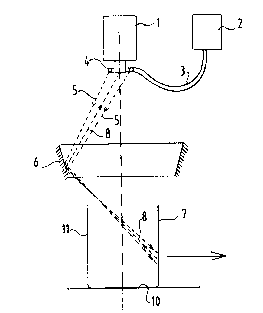Some of the information on this Web page has been provided by external sources. The Government of Canada is not responsible for the accuracy, reliability or currency of the information supplied by external sources. Users wishing to rely upon this information should consult directly with the source of the information. Content provided by external sources is not subject to official languages, privacy and accessibility requirements.
Any discrepancies in the text and image of the Claims and Abstract are due to differing posting times. Text of the Claims and Abstract are posted:
| (12) Patent Application: | (11) CA 2002569 |
|---|---|
| (54) English Title: | DEVICE FOR INSPECTING THE INNER WALL OF A BODY |
| (54) French Title: | DISPOSITIF D'INSPECTION DE LA PAROI INTERNE D'UN CORPS |
| Status: | Deemed Abandoned and Beyond the Period of Reinstatement - Pending Response to Notice of Disregarded Communication |
| (51) International Patent Classification (IPC): |
|
|---|---|
| (72) Inventors : |
|
| (73) Owners : |
|
| (71) Applicants : |
|
| (74) Agent: | SMART & BIGGAR LP |
| (74) Associate agent: | |
| (45) Issued: | |
| (22) Filed Date: | 1989-11-09 |
| (41) Open to Public Inspection: | 1990-05-28 |
| Availability of licence: | N/A |
| Dedicated to the Public: | N/A |
| (25) Language of filing: | English |
| Patent Cooperation Treaty (PCT): | No |
|---|
| (30) Application Priority Data: | ||||||
|---|---|---|---|---|---|---|
|
ABSTRACT
The invention relates to the inspection of the
inside of a body, for example the inner surface of a metal
container such as a preserves can.
The best possible inspection is ensured with light-
ing from the same direction as that from which the inspection,
for example with a video camera, takes place. The invention
therefore provides a device for inspecting the inner surface
of a hollow body such as a metal container with a cylindrical
standing wall and a bottom, which device comprises:
positioning means for placing the body at a chosen
position;
a light source which is placed relative to the
positioning means such that it can light the said inner sur-
face at least approximately uniformly; and
an inspection means, for example a video camera,
which is placed relative to the positioning means such that
it can inspect the said inner surface,
whereby the direction of lighting and the direction
of inspection of each portion of the said inner surface at
least approximately coincide.
Note: Claims are shown in the official language in which they were submitted.
Note: Descriptions are shown in the official language in which they were submitted.

2024-08-01:As part of the Next Generation Patents (NGP) transition, the Canadian Patents Database (CPD) now contains a more detailed Event History, which replicates the Event Log of our new back-office solution.
Please note that "Inactive:" events refers to events no longer in use in our new back-office solution.
For a clearer understanding of the status of the application/patent presented on this page, the site Disclaimer , as well as the definitions for Patent , Event History , Maintenance Fee and Payment History should be consulted.
| Description | Date |
|---|---|
| Inactive: IPC from MCD | 2006-03-11 |
| Inactive: Abandon-RFE+Late fee unpaid-Correspondence sent | 1996-11-11 |
| Inactive: Adhoc Request Documented | 1996-11-11 |
| Application Not Reinstated by Deadline | 1993-05-09 |
| Time Limit for Reversal Expired | 1993-05-09 |
| Inactive: Adhoc Request Documented | 1992-11-09 |
| Deemed Abandoned - Failure to Respond to Maintenance Fee Notice | 1992-11-09 |
| Application Published (Open to Public Inspection) | 1990-05-28 |
| Abandonment Date | Reason | Reinstatement Date |
|---|---|---|
| 1992-11-09 |
Note: Records showing the ownership history in alphabetical order.
| Current Owners on Record |
|---|
| HEUFT-QUALIPLUS B.V. |
| Past Owners on Record |
|---|
| MARCELLINES J. J. OBDEIJN |